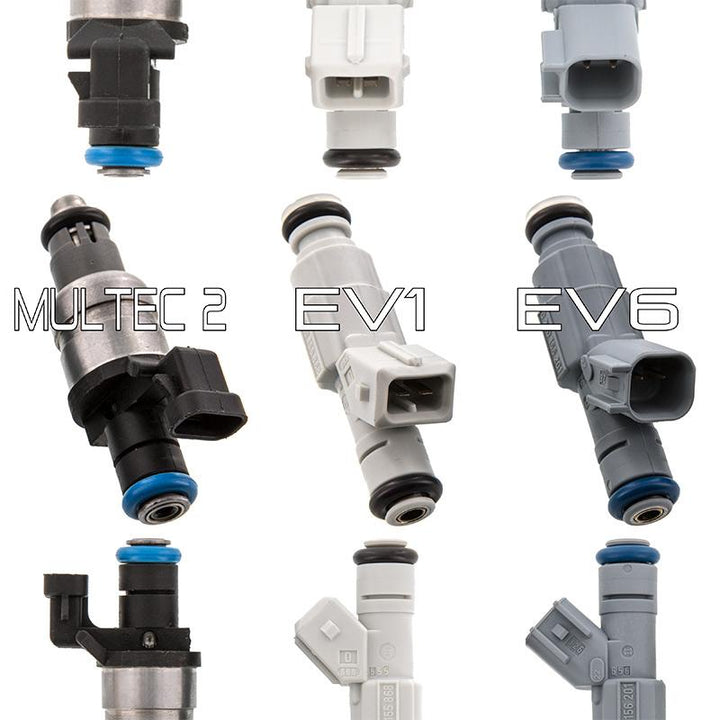Fueling
Injectors
The stock injectors on a 3800 really are not that great for higher horsepower builds. There is a little bit of headroom with the L67 injectors, but once you start using a turbo or a small supercharger pulley you will start to exceed the capabilities of the stock injectors.
At this point you will need to look at some of the aftermarket fuel injectors. There is plenty of aftermarket for fuel injectors so it's just a matter of finding the largest injector you think you'll need and tuning your computer to take use them properly. At this point you will want to look at your fuel pump as well.
Stock injectors
The 3800 came equipped with different injectors depending on whether it's a series 2 or 3, and if it is supercharged or naturally aspirated.
All Series 2 and 3 injectors are 60mm injectors.
| Engine | pre-series 1 N/A | series 1 N/A | Series 1 Supercharged | Series 2 N/A | Series 2 Supercharged | Series 3 N/A | Series 3 Supercharged |
|---|---|---|---|---|---|---|---|
| RPO Code | LN3 | L27 | L67 | L36 | L67 | L26 | L32 |
| Fuel Injector size | 19 lb/hr | 22 lb/hr | 28 lb/hr | 22 lb/hr | 36 lb/hr | 22 lb/hr | 33 lb/hr |
The series 3 3800 is a bit different than prior versions because it utlizes a returnless fuel system and the injectors use the EV6 connector. Series 2 and earlier motors will use a retun-style fuel system and EV1 fuel injectors.

You can use an adapter to convert between the two connector types if necessary.
Fuel Rails
There are a lot of differences in fuel rails for each motor and each different intake manifold.
Non-supercharged motors and supercharged motors have very different fuel rails as well due to the injector holes being placed in different locations. Supercharged motors (L67 and L32) have injector ports in the heads. Naturally-Aspirated motors have injector ports in the lower intake manifold.
In theory you could run both the L67/L32 style heads with the L36/L26 intake manifolds to double the amount of available injector capacity. This would be a dual fuel rail setup, something that is pretty common in the aftermarket world among other platforms.
This is not that practical with the stock PCM since there is no simple way to enable/disable injectors properly. An aftermarket ECU would be far better for this type of setup.
There are a few companies that make aftermarket fuel rails as well for the 3800. Those can be used to easily adapt AN lines to the fuel rail, or an aftermarket fuel pressure regulator, or to simplify the fuel rails when using a tall intercooler.
Currently ZZP and Aeromotive are the only companies offering billet fuel rails:
https://zzperformance.com/collections/3800/products/zzp-billet-fuel-logs-gen2
https://aeromotiveinc.com/product/96-07-gm-supercharged-3-8l-fuel-rail-kit/
Fuel pump
The factory fuel pump is sufficient for light modding, however heavier mods will need a fuel pump upgrade. Your results will vary, but just pick out whatever makes sense for your power level and the type of fuel that you're using.
Every fuel pump's performance will vary based on base fuel pressure and voltage supplied so take these numbers with a grain of salt. In general this is a good outline of a safe fuel pump size for the amount of power you're trying to make:
| Fuel Pump Free Flow | Fuel Injected Engine | Fuel Injected w/ Power Adder | Fuel Injected w/ Power Adder E85 |
| 30 gph/114 lph | 300 hp | 250 hp | 175 hp |
| 40 gph/155 lph | 400 hp | 300 hp | 210 hp |
| 50 gph/190 lph | 500 hp | 400 hp | 280 hp |
| 67 gph/255 lph | 650 hp | 500 hp | 350 hp |
| 90 gph/340 lph | 850 hp | 600 hp | 420 hp |
| 125 gph/470 lph | 1000 hp | 800 hp | 560 hp |